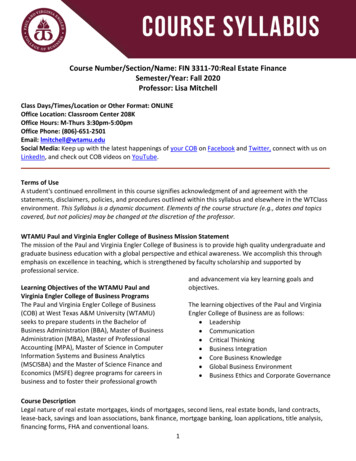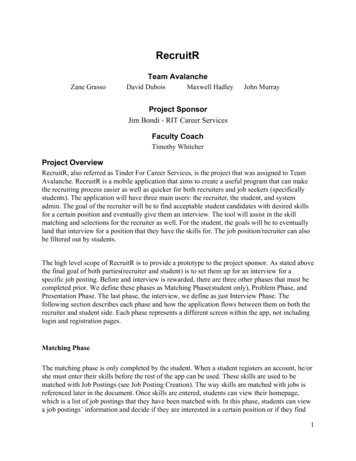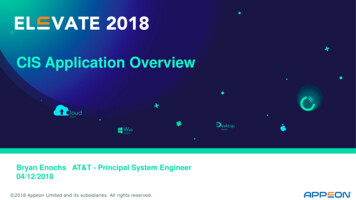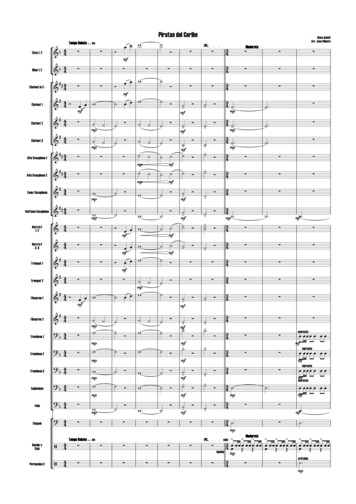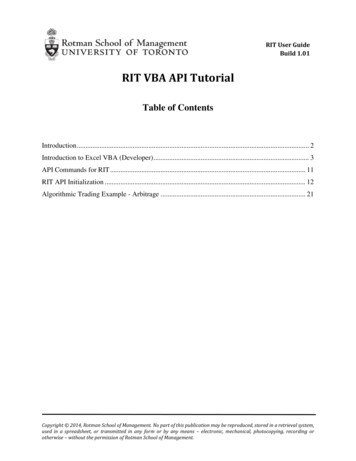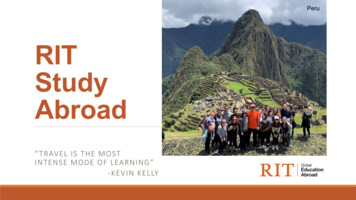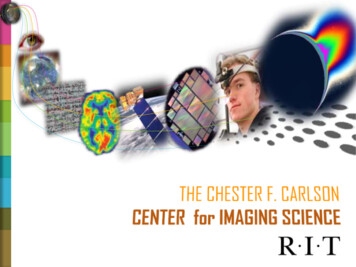
Transcription
INTRODUCTIONWhat is ImagingScience?WHAT MAKES IMAGINGSCIENCE UNIQUETHE IMAGING SCIENCECURRICULUMCutting Edge TechnologyRequirementsPreparationCourse OutlineFlexibility4 1 ProgramCommunityBackground: rendering of an ASTER satellite image of Morenci Mine in ArizonaASTER: Advanced Spaceborne Thermal Emission and Reflection Radiometer
GLOBAL REACHCo-op OpportunitiesStudy Abroad IESUnique opportunities forstudents and graduatesof Imaging ScienceCLOSING REMARKSTestimonialsFurther Information(back arizona-morenci-mine.html
QUESTION: DOHELP THE WORLDENGINEER NEW OPTICALHELP KEEPRESPOND TO NATURALAND SPECTROSCOPICOUR NATION SECUREDISASTERSSYSTEMS01TO DETECTSENSOR SYSTEMS,VOLCANOES, TSUNAMIS,EARTH-LIKE PLANETSALGORITHMS,FIRES, ANDAND SEARCH FOR LIFEAND VISUALIZATIONHURRICANES?IN THE UNIVERSE?TECHNIQUES ?NASALIKE FLOODS,YOUAND MORE AP file photoBY DESIGNING NEW
YOU WANT TO SECRETSDEVELOP NEW TECHNIQUESIN ANCIENTTO DIAGNOSE AND CUREDOCUMENTS?WITHDISEASE?RECREATE FAMOUSWORKS OF ARTIN THEIR ORIGINALPALETTES?IMAGING SCIENCE.READ ONUNEARTH HIDDEN02
Emission spectrum of Neon - Jan Homann OpticsNanoimagingThe Chester F. Carlson Center for Imaging Scienceat RIT is a highly interdisciplinary universityresearch and education ImageMicrostructureBiomedical
dedicated topushing the frontiers ofimaging in all its forms and uses. Emission spectrum of Helium – Jan HomannColorScienceJ. PowDetectorDesignandEngineeringSeeing theInvisibleJ. Spectrum04
CUTTING EDGE“ For centuries keener vision meant to see more clearly what was faraway or what was very small—to magnify and sharpen. But in the20th century it also came to signify all sorts of vision that once wouldhave been deemed ’magic’—the penetration of veils both around usand within us as well as the registering of forms of ‘light’ to whichhuman sight is utterly blind.”www.greatachievements.orgImaging Scientists are responsible forsuch high-tech innovations as DIGITAL CAMERAS - CCD/CMOSTECHNOLOGYFINGERPRINT/RETINASCANNERS AND IDENTIFICATIONSATELLITE IMAGING SYSTEMSRADAR/SONAR/LIDARNIGHT VISION EQUIPMENTSCANNERS/FAX/COPIERSMEDICAL IMAGINGMRI, PET/CT-SCAN, X-RAY05J. Pow
Application-Based Curriculum The Imaging Science curriculum is basedupon knowledge application and preparation for entering the science andengineering work force.Dedicated, Accessible Faculty Because many professors are active inresearch and consulting, they bring real-world issues to the classroom andchallenge students to evaluate the latest scientific developments. PREPARATIONResearch opportunities for Undergraduates Under theguidance of a faculty research advisor, students design their ownproject, carry out all of the experiments, and analyze andinterpret the results. Opportunities exist for earning credits,presenting at scientific meetings, and getting published inprofessional science journals.“Classroomlearning isonly one partof an RITeducation.”Internships and Cooperative Education (Co-op) (optional) Co-op’salternate periods of paid, professional work in Imaging Science careerswith periods of on-campus study. See more information on Page 9.06
Students undertake a laboratory intensiveprogram that combines Physics,Mathematics,Computer Scienceanden route to a degree with awide variety of exciting career options. FLEXIBILITYApplication areas of imaging are diverse.Imaging Science is both exceptionallyinterdisciplinary in its content andmulti-disciplinary in its applications.Imaging Science graduates enter into careers spanning Systems Engineering, Software Engineering,Design and Development, Physics, Defense, Research Wherever you want to go, Imaging Science can take you there.07
A STUDENT-CENTERED ENVIRONMENTJ. PowRIT’s Center for Imaging Science combines thebest features of a large university—achallenging academic curriculum, state-ofthe-art facilities and technology, andextensive after-class opportunities —with thebenefits of a small college—intimate,interactive classes, personal attention fromprofessors, and staff members who know you.COLLABORATION AND TEAMWORKBeing successful in the real world requiresthat you know how to work with others.That’s why programs at RIT and in ImagingScience emphasize project-based learning,teamwork, and interaction among students,often from other science disciplines. Asstudents collaborate, they learn to becreative, flexible, and confident in their owncritical thinking, problem solving, andcommunication abilities. COMMUNITY08
Imaging Science//Bachelor of Science//Sample Curriculum*First YearSecond YearImaging Science SeminarImaging in the Physical SciencesScience Electives with LabsCalculus I, II, IIIUniversity Physics I, IILiberal ArtsFirst-Year EnrichmentWellness-EducationProgramming for Imaging ScienceIntroduction to Imaging SystemsGeometrical OpticsPhysical OpticsLinear Mathematics for ImagingVision and PsychophysicsRadiometryMultivariable CalculusUniversity Physics IIIModern PhysicsLiberal ArtsCooperative Education (optional)Transfer student?The Imaging Sciencecurriculum offers suchflexibility that transferring issimple. Students can easilycarry over credit from APclasses, 2-year colleges,or other 4-yearuniversities.09Background: A rendering of an X-ray fluorescence image of the centuries-oldArchimedes Palimpsest, An original image can be seen to the left,being processed by Imaging Science student Matthew Heimbueger.For more information on the history of this document and its imaging research efforts , visithttp://www.archimedespalimpsest.org/
* While this is the typical plan of study that Imaging Science students follow, variations are possible.See: http://www.cis.rit.edu/undergraduate/alternate for some of our many options.Third Year and Fourth Years4 of these 6 classes:Imaging Systems I, II, IIIColor ScienceInteractions Between Light and MatterDigital Image Processing I, IIProbabilityDetectorsResearch PracticesLiberal ArtsSenior Project I, II (optional)Professional ElectivesDigital Imaging MathematicsRadiometryThe Human Visual SystemOpticsProbability, Noise, and System ModelingDigital Image Processing4 1 BS/MS OptionInquire for DetailsSee http://www.cis.rit.edu/undergraduate/4plus1Minors are available in a range of areas, including astronomy, economics, psychology, music, business,foreign language, and more. A five-course minor can show employers you have something extra to offer.See our complete list of minors online: http://www.rit.edu/programs/ugrad/minors/10
CO-OP OPPORTUNITIES(optional)Imaging Science students are uniquely prepared to effectively begin research work in as little as 1 year.Imaging Science students have completedCo-Op employment at companies such as: ITT Industries –Space Systems Division U. of Texas Health Science CenterCo-op Education gives studentsexposure to the opportunities availablein Imaging Science, deepens theunderstanding of academic studies, andprovides a substantial salary. The Aerospace Corporation NASA Boeing Naval SurfaceWarfare Center Ball Aerospace BAE Systems Hewlett-Packard11Co-op can fitseamlessly into theImaging Sciencecurriculum, withoutcausing the studentto fall behind orrequire extra time.
STUDY ABROADThere is no better way to gain an understanding of another culture than to experience it firsthand.In programs affiliated withother institutions, RITstudents also have theopportunity to study inItaly, Spain, France,Ireland, Australia,China, Kenya, NewZealand, Germany,Greece, South Africa,and other internationallocations.RIT’s Study Abroadprograms are offered incooperation with: The AmericanCollege ofManagement andTechnology (Croatia) Queens University(England) University ofOsnabruck (Germany) Kanazawa Instituteof Technology (Japan)Imaging Science student Dave Kelbe in Fiordland, New Zealand during his study abroad program12
SCHOLARSHIPSThere is money waiting for Imaging Science students.Exclusively for Imaging Science StudentsRelated External ScholarshipsCarlson Family Scholarship Merit scholarship foraccepted undergraduate freshman and transferstudents based on scholarship, leadership andservice.The Society for Imaging Science &Technology:The Raymond Davis ScholarshipThe Carlson Scholarship in Imaging ScienceFrancis Lang Memorial ScholarshipFitz ScholarshipJerry Hughes ScholarshipInternational Society of Optical Engineering(SPIE)Boeing Corporation - Boeing ScholarshipUnited States Department of Homeland Defense- Department of Homeland Security ScholarshipUnited States Geospatial-InformationFoundation - United States GeospatialInformation Foundation ScholarshipFor RIT College of Science StudentsJohn Wiley Jones ScholarshipAmerican Society for Photogrammetry andRemote Sensing - Central New York Region Student of the Year AwardFor more information, visit: http://www.cis.rit.edu/undergraduate/scholarships awards13Background: Example Image Microstructure of US Currency
POST-GRADUATIONImaging Science graduates enjoy a nearly 100% acceptance rate into the school or career of their choice.Imaging Scientists are in high demandfrom many companies, including:BOEINGNASA (NATIONAL AERONAUTICSAND SPACE ADMINISTRATION)CANONNATIONAL GEOSPATIAL-INTELLIGENCEAGENCY (NGA)GEOSPATIAL SYSTEMS INCORPORATEDNATIONAL RECONNAISSANCE OFFICEHP (HEWLETT-PACKARD)NOAA (NATIONAL OCEANIC ANDATMOSPHERIC ADMINISTRATION)ITT INDUSTRIES SPACE SYSTEMSDIVISIONPICTOMETRY INTERNATIONAL CORP.KODAKTELEDYNE SCIENTIFIC & IMAGINGLEICA GEOSYSTEMSTHE U.S. ARMY RESEARCH OFFICELOCKHEED MARTINTHE U.S. FOREST SERVICELOGICAL IMAGESVIRTUALSCOPICSLOS ALAMOS NATIONAL LABORATORYXEROXGraduate school placement Imaging Science graduates enjoy a high rate of acceptance intohighly respected, top-notch graduate programs in science, engineering, business, and other fieldsof study throughout the country, and the world.14
I originally wanted to study film, but was looking for a morechallenging and in-demand career path. Imaging Scienceprovides the ultimate combination between mathematicsand visual mediums, so I can study all of my passions. Themultidisciplinary nature of Imaging Science allows me thefreedom not to commit to only one specific path; I know thatI will feel prepared for whatever I want to do aftergraduation.-Joel Witwer. Imaging Science Class of ‘11Imaging Science combines all of my interests inmath, physics, science, and programming, and isflexible enough that I can customize the program tofit me. There are also plenty of lucrativeopportunities for Imaging Science students; I hadthe opportunity to perform summer research undera grant from NASA. While that was in the field ofAstronomy, I personally plan to pursue BiomedicalImaging. What other major allows for that muchvariety?- Karla Hatfield, Imaging Science Class of ‘1115
The undergraduate program in Imaging Science isthe only program in the United States totallydedicated to the physics, mathematics, and appliedcomputation that relate to all aspects of imaging.We study everything from the molecularinteractions within materials that make up theworld and how they affect the optical properties ofthese objects all the way to how the human visualsystem interprets the imagery that it is presentedon your computer monitor, HDTV, and your cellphone. And the best part is if you are wonderingwhat sort of opportunities you will have when youleave RIT, the answer is pretty much unlimited.Imaging is such a big part of our lives everydaythat it is hard to find anything that you would notbe able to get involved in . so prospect of getting ajob is the last thing that keeps our students up atnight.-Dr. Carl Salvaggio, Assoc. Professor andUndergraduate Program Coordinatorin the Center for Imaging ScienceBackground: rendition of MacBeth Color Checker16
FOR MORE INFORMATION, PLEASE //www.cis.rit.eduE-mail us:http://www.cis.rit.edu/contactChester F. Carlson Center for Imaging ScienceRochester Institute of Technology54 Lomb Memorial DriveRochester, New York 14623(585) 475-5944
RIT’s Study Abroad programs are offered in cooperation with: The American College of Management and Technology (Croatia) Queens University (England) University of Osnabruck (Germany) Kanazawa Institute of Technology (Japan) In programs affiliated with other institutions, RIT studen

